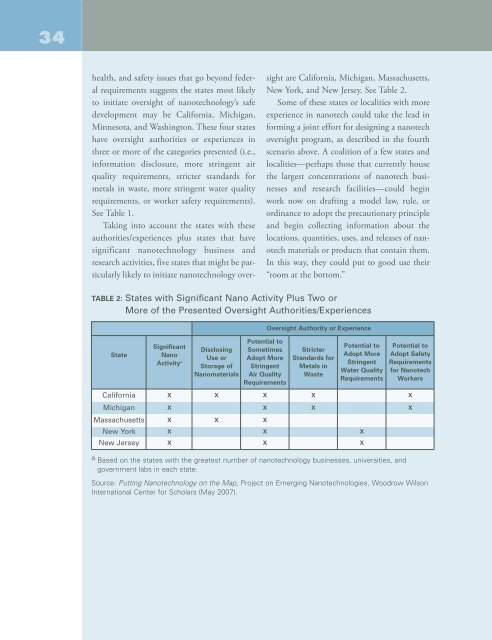ROOM AT THE BOTTOM? - Project on Emerging Nanotechnologies
ROOM AT THE BOTTOM? - Project on Emerging Nanotechnologies
ROOM AT THE BOTTOM? - Project on Emerging Nanotechnologies
You also want an ePaper? Increase the reach of your titles
YUMPU automatically turns print PDFs into web optimized ePapers that Google loves.
34<br />
health, and safety issues that go bey<strong>on</strong>d federal<br />
requirements suggests the states most likely<br />
to initiate oversight of nanotechnology’s safe<br />
development may be California, Michigan,<br />
Minnesota, and Washingt<strong>on</strong>. These four states<br />
have oversight authorities or experiences in<br />
three or more of the categories presented (i.e.,<br />
informati<strong>on</strong> disclosure, more stringent air<br />
quality requirements, stricter standards for<br />
metals in waste, more stringent water quality<br />
requirements, or worker safety requirements).<br />
See Table 1.<br />
Taking into account the states with these<br />
authorities/experiences plus states that have<br />
significant nanotechnology business and<br />
research activities, five states that might be particularly<br />
likely to initiate nanotechnology over-<br />
sight are California, Michigan, Massachusetts,<br />
New York, and New Jersey. See Table 2.<br />
Some of these states or localities with more<br />
experience in nanotech could take the lead in<br />
forming a joint effort for designing a nanotech<br />
oversight program, as described in the fourth<br />
scenario above. A coaliti<strong>on</strong> of a few states and<br />
localities—perhaps those that currently house<br />
the largest c<strong>on</strong>centrati<strong>on</strong>s of nanotech businesses<br />
and research facilities—could begin<br />
work now <strong>on</strong> drafting a model law, rule, or<br />
ordinance to adopt the precauti<strong>on</strong>ary principle<br />
and begin collecting informati<strong>on</strong> about the<br />
locati<strong>on</strong>s, quantities, uses, and releases of nanotech<br />
materials or products that c<strong>on</strong>tain them.<br />
In this way, they could put to good use their<br />
“room at the bottom.”<br />
TABLE 2: States with Significant Nano Activity Plus Two or<br />
More of the Presented Oversight Authorities/Experiences<br />
State<br />
Significant<br />
Nano<br />
Activity a<br />
Disclosing<br />
Use or<br />
Storage of<br />
Nanomaterials<br />
Potential to<br />
Sometimes<br />
Adopt More<br />
Stringent<br />
Air Quality<br />
Requirements<br />
Oversight Authority or Experience<br />
Stricter<br />
Standards for<br />
Metals in<br />
Waste<br />
Potential to<br />
Adopt More<br />
Stringent<br />
Water Quality<br />
Requirements<br />
a Based <strong>on</strong> the states with the greatest number of nanotechnology businesses, universities, and<br />
government labs in each state.<br />
Potential to<br />
Adopt Safety<br />
Requirements<br />
for Nanotech<br />
Workers<br />
California X X X X X<br />
Michigan X X X X<br />
Massachusetts X X X<br />
New York X X X<br />
New Jersey X X X<br />
Source: Putting Nanotechnology <strong>on</strong> the Map, <str<strong>on</strong>g>Project</str<strong>on</strong>g> <strong>on</strong> <strong>Emerging</strong> <strong>Nanotechnologies</strong>, Woodrow Wils<strong>on</strong><br />
Internati<strong>on</strong>al Center for Scholars (May 2007).
















